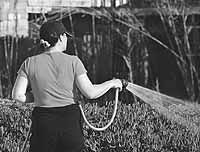| Some people enjoy watering their yards by hand, but most prefer the convenience of sprinkers. |
When it comes to watering a lawn, it is important to have the proper sprinkler.
There are six general types available: impulse, oscillating, rotary, stationary, hose and traveling sprinklers. The right sprinkler for a lawn depends on three key factors: the size and layout of the yard, soil type and the ideal rate of water flow.
Impulse sprinklers have a single water jet that sits close to the ground. They are durable and less likely to clog compared to other types of sprinklers. Impulse sprinklers distribute water evenly over a large area in a circular or semi-circular pattern.
Oscillating sprinklers spray many jets of water from a long tube and when in use, the water tends to look like a fan. They can water large areas quickly in a rectangular or square pattern and the area of distribution can be adjusted on most models. The gentle spray of an oscillating sprinkler is ideal for newly seeded areas and clay soils that absorb water slowly.
Rotary sprinklers consist of a spinning unit with two or three arms that have water jets on the ends. Also called spinning sprinklers, they lay down water quickly, generally at a rate of one inch per hour. Rotary sprinklers generally have a low distribution radius and would work well on smaller lawns and gardens.
Stationary sprinklers are usually the least expensive and come in ring or “salt shaker” styles. They are low to the ground and distribute water unevenly in a circular pattern. Although they can work with low water pressure, stationary sprinklers have a low throw radius and are not recommended for larger yards.
Sprinkler hoses have a low flow rate and work well for long, awkward shaped or sloped lawns, but can be somewhat difficult to set up for even coverage. As hose sprinklers age, they can begin to form creases, which can affect water pressure and area of distribution. Another type of hose sprinkler is the soaker hose, which is normally installed semi-permanently in planting beds under a layer of mulch.
Traveling sprinklers follow the garden hose or a guideline on wheels attached to the base. Two rotating arms spray water in a circular pattern as the sprinkler follows its guide and these arms can be adjusted to vary the diameter of the spray circle. Also called self-propelled sprinklers, they water large irregular patterns over the course of several hours and are ideal for long alleys of lawn.
If this type of sprinklers is chosen, make sure it has an automatic shut off valve.
Anyone interested in maintaining a lush garden or beautiful lawn also knows the importance of owning the right hose. To be a success, large amounts of water must be moved from one place to another, and owning the right hose makes life a whole lot easier.
Buying the correct length of hose is key. When in doubt, buy the longer hose. Hoses typically come in 50, 75 and 100-foot lengths. Measuring the watering space from the spigot to the furthest point often tells most homeowners that the 100-ft length is the right choice. Stretching short hoses to their limit tends to promote kinking and unwanted pressure to spigots. Each spigot around a home should be outfitted with the correct length of hose.
Today’s hoses are made of plastic, rubber or vinyl and often have several plies combining these materials. Vinyl or meshed jacketing is common for increasing the strength and flexibility of the hose. Rubber hoses remain more flexible during the colder months than the other materials, and bounce back from kinking better than vinyl varieties.
Hoses typically come in three different diameters: 1/2, 5/8 and 3/4 inches. Smaller yards only require the 1/2-inch diameter, but 5/8-inch is standard for most homes. Choose the commercial 3/4-inch diameter hose if you need to fill ponds or pools. The larger diameter hose moves 65 percent more water than the 5/8-inch diameter hose.
New soaker hoses, flat reel hoses and recoiling hoses are coming out each spring, as well as every kind of spray attachment nozzle possible.

